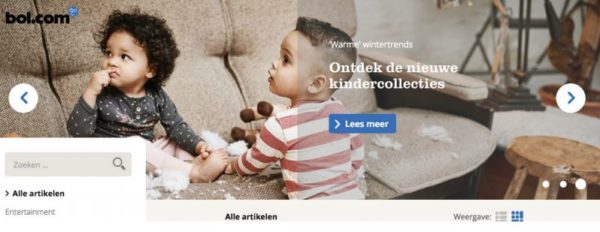Retailers that lead the way in European brand engagement invest in finding new ways to reach existing and potential customers, writes Chloe Rigby
RETAILERS AT THE of European ecommerce are working out how to start and develop conversations with consumers in other countries as they push towards growing domestic and cross-border sales in a market that’s set to reach €500bn in value this year.
They’re engaging with consumers through events, blogs and email marketing campaigns, and they’re amplifying these messages at scale with the adept use of social media.
In recent years, European consumers have developed an appetite for buying online from overseas retailers. As fulfilment has become easier and faster, retailers have moved to localise their online offerings. European brands from L’Oréal to Clarins, and retailers including Decathlon , Otto Group , Zara and H&M , now operate international ecommerce platforms with websites that are localised for markets across Europe. These sites let shoppers browse in a language of their choosing, pay in local currencies and use familiar payment methods. Leaders in the IREU Top500 Brand Engagement Performance Dimension go still further, talking to shoppers through localised email campaigns, in their native language and on the social media platforms they prefer.
This InternetRetailing research measures localisation through indicators, such as whether retailers have country-specific customer service channels, social media offerings aimed at specific territories and the number of languages and currencies that are offered. The clear leaders that emerge are those retailers that tailor messages to specific markets, initiate and then sustain conversations with consumers, and do so across multiple, closely linked channels.
Decathlon, for example, communicates with shoppers in their own languages and across the communications channel that is most relevant for each market. In the UK, says Decathlon UK’s PR and conversations manager Kieran O’Shea, social media channels such as Twitter are particularly important since the sports equipment retailer has a relatively small number of UK stores – at the time of writing it had 26. In its domestic market of France, by contrast, it had 290 and is more likely to use social media to promote store-based services such as click and collect, engaging with customers through this more frequented channel.
Setting the context
This InternetRetailing Dimension Report comes at a time when ecommerce is growing across the continent. Ecommerce Europe’s 2016 European B2C Ecommerce Report predicted that turnover from ecommerce would grow to €500bn this year, from €455.3bn last year. In 2015, it suggested, 16% of people in the 28 countries of the European Union bought goods or services from other countries in the region, 33% up on a year previously. Customers were attracted, the report found, by competitive prices, and a wider range of goods and services.
That’s supported by research from Bronto Software that suggests 80% of online shoppers in the UK – Europe’s most mature ecommerce market – would now consider buying from a retailer outside the country, and that 44% have already done so. Indeed, finds the Where we buy: consumer attitudes on global ecommerce report, 39% are shopping across borders at least once a month. Six out of 10 (62%) of those that buy across borders say they do so in order to find unique products while 50% are searching for better prices.
Engaging across channels
Leading retailers meet this willingness to buy by making it increasingly easy for shoppers to do so. Brand engagement is, at heart, all about communicating with customers. So a shopper who can recognise a retailer is more likely to trust and buy from the retailer. At the same time, being recognised also makes retailers more visible in search. “To be a visible brand in Europe,” says Martin Shaw, senior researcher at InternetRetailing, “retailers need to localise and focus on the channels most appropriate to the different territories in which they operate.” Word of mouth from friends and peers remains as important as it always was but today, the reach of these personal recommendations is amplified through social media.
Each year, French electronics and hobby retailer Fnac attracts thousands to its free music festival, Festival Fnac Live, an event that’s amplified through third-party websites with news and images, as well as through Fnac’s own channels.
German fashion-to-homewares retailer Otto shares its stylists’ advice at scale through YouTube videos that reach many more people that any individual could ever speak to in store. An Otto DIY styling video on copying Rihanna’s look has had more than 2,000 views on YouTube, while a guide to pimping a bikini has had more than 65,000 views.
The social media effect is enhanced still further when retailers talk to shoppers in markets beyond their own. In Europe, traders selling in markets with common languages – such as France and Switzerland, or Switzerland, Germany and Austria – can most easily operate beyond their own borders. Those selling in English may benefit from the widespread knowledge of the language, though it’s worth noting that Boohoo.com, a UK retailer that scores highly in this area, enables its shoppers to interact with it in four country-specific languages, French, Dutch, German and Spanish.
Raising awareness
Social media activity can also serve to raise the profile of a brand in ways that have positive effects on brand awareness. Being well known raises the probability that a brand is visible in search results, something we’ve measured for this research through search visibility. Well known retailer Amazon, for example, stands out in search visibility across much of the EEA. In the UK, it features in 262m search results a month when the average for a UK Top500 retailer is 3.4m. IREU Top500 retailers were seen in an average of 7m Google searches and had a 35% chance of being seen in the results of a relevant search. By investing in a social media presence, or putting resources into an on-site blog, retailers can help to improve their position. The blog at Dutch online department store Bol.com, for example, is very active and has strong imagery that helps to bring the site to life. Updated daily, it features competitions, discounts and a range of buying guides. Inspirational photography helps to bring the site to life.
As we see in the analysing the numbers feature, this activity can be particularly useful for retailers that enjoy some kind of niche. For by ranking highly for niche terms, it’s likely that a retailer will outperform general traders on those terms.
Better email performance
Brands can very successfully develop initial customer contacts and purchases when they sign them up to receive regular emails. Research conducted by InternetRetailing Knowledge Partner Return Path (see page 30) suggests that customer attitudes towards emails can vary significantly between different markets. It may therefore be worth considering differentiating the subject or time of day that emails are sent between different European countries. The study covered the UK, Germany and France and its findings included the suggestion that German recipients are more likely to read a marketing email in the evening, while UK read rates are highest between 6am and noon, reflecting the fact that in the UK, retail audiences tend to be using a smartphone. In France, it’s likely that cultural differences feed into the fact that recipients are more likely to check their emails over breakfast before heading to work or school, which both generally start at a later time than in Germany.
Meanwhile, in both Germany and the UK, emails are more likely to be read on Tuesdays, Thursdays and Sunday – but not on a Saturday. Opposite effects are seen in France.
The study also found that leading UK retailer Waitrose enjoys average read rates of 37.8%, some 77% higher than the retail average of 21.3%. It sees exceptionally high levels of engagement from the gardening themed emails it often sends out on a Sunday. This, says Return Path, reflects a “Sunday supplements” approach among UK shoppers, who have more time to review offers and take on longer-term planning.
In conclusion
We seem to be living through a period in which customers are becoming more eager to engage with new and interesting brands, regardless of whether they come from the same country or not. This starts to open up an enormous opportunity for European retailers to establish new digital trade routes through the wider European Economic Area, which is home to more than half a billion potential consumers. More retailers are investing in that possibility, launching more local language websites that enable shoppers to browse and pay in familiar ways. This research suggests that only those retailers that connect at a deeper and more powerful level will make lasting connections.







